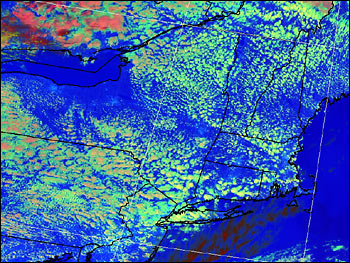

 |
On a soggy morning this past April, Daniel Rosenfeld moved briskly through an
overcast parking lot into one of many monolithic brick structures that dot NASA’s Goddard Space Flight
Center. When he arrived at the conference room, he switched on a laptop and began bringing up satellite
images of what looked like an apocalyptic vision of the East Coast. From Massachusetts to North
Carolina, swirling red, orange and yellow clouds floated above a blue landscape. |
|||

Peering over his glasses and intently at the screen, he pointed to an especially fiery spot on the map
near the border of Pennsylvania and New Jersey. "The atmosphere here is fully polluted," he said. "Those
colored streaks are mostly due to man-made aerosols." |
The dense concentration of powerplants, factories, trucks, and automobiles on the U.S. east coast continuously emit soot and other particulate pollutants into the sky. These small particles suspended in the air—aerosols—often end up interacting with clouds, forming more, smaller droplets than those found in an unpolluted cloud. In this satellite image the yellow clouds scattered over the northeast are polluted clouds with small water droplets. The pink clouds over Canada have larger droplets, and are relatively clean. Because the aerosols prevent cloud water droplets from growing large enough to precipitate, this type of pollution can reduce rainfall. (Image by Daniel Rosenfeld, Hebrew University of Israel) |
||
He went on to explain that aerosols in this instance have little to do with household cleaning products. For atmospheric scientists such as him, aerosols are defined as any microscopic particle suspended in the atmosphere. Not only do they make our sunsets particularly vivid and our air particularly gritty on a hot summer’s day, but they also create clouds in the sky. While most atmospheric aerosols originate from natural sources such as the sea spray and volcanoes, he said nearly all the color enhanced yellow and orange clouds in his image have been affected by aerosols created by factories, power plants and cars up and down the East Coast. For the past six years, Rosenfeld and a team of scientists from the Hebrew University of Israel used NASA satellites and remote sensing techniques to track how man-made aerosols change clouds. They recently discovered that aerosol particles from factories and power plants increase the number of droplets in clouds they pollute. In doing so, the pollutants create brighter clouds that retain their water and do not produce rain. These results put to rest a decades-long debate about human-generated pollutants and biomass burning as well as verify that our manufacturing processes and our need for energy are changing the global climate and local weather systems. The data used in this study are available in one or more of NASA's Earth Science Data Centers. |
What Are Aerosols? contains background information about aerosols and their effect on climate. |